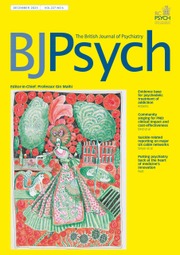Crossref Citations
This article has been cited by the following publications. This list is generated based on data provided by
Crossref.
Puri, Basant K.
1996.
eMagRes.
Joseph, R.
1999.
Frontal Lobe Psychopathology: Mania, Depression, Confabulation, Catatonia, Perseveration, Obsessive Compulsions, and Schizophrenia.
Psychiatry,
Vol. 62,
Issue. 2,
p.
138.
Malizia, Andrea L.
1999.
What do brain imaging studies tell us about anxiety disorders?.
Journal of Psychopharmacology,
Vol. 13,
Issue. 4,
p.
372.
Rauch, Scott L.
Benkelfat, Chawki
Dager, Stephen R.
Greenberg, Benjamin D.
Hendler, Talma
Hollander, Eric
Laruelle, Marc
Rosenberg, David R.
Saxena, Sanjaya
Zohar, Joseph
and
Baxter, Lewis R.
1999.
Neuroimaging Research and Neurocircuitry Models of Obsessive-Compulsive Disorder: Proceedings of the Third IOCDC.
CNS Spectrums,
Vol. 4,
Issue. S3,
p.
25.
Castle, David J.
and
Groves, Aaron
2000.
The Internal and External Boundaries of Obsessive–Compulsive Disorder.
Australian & New Zealand Journal of Psychiatry,
Vol. 34,
Issue. 2,
p.
249.
Kopell, Brian Harris
and
Rezai, Ali R.
2000.
The Continuing Evolution of Psychiatric Neurosurgery.
CNS Spectrums,
Vol. 5,
Issue. 10,
p.
20.
MIKHAIL, ASHRAF G.
KENT, JUSTINE M.
and
PINE, DANIEL S.
2000.
Childhood Obsessive-Compulsive Disorder: A Review.
Journal of Psychiatric Practice,
Vol. 6,
Issue. 4,
p.
177.
Graybiel, Ann M
and
Rauch, Scott L
2000.
Toward a Neurobiology of Obsessive-Compulsive Disorder.
Neuron,
Vol. 28,
Issue. 2,
p.
343.
Baving, L.
and
Schmidt, M.H.
2000.
Zwangsstörung, frontostriatales System und Beeinflussung des serotonergen Systems.
Zeitschrift für Kinder- und Jugendpsychiatrie und Psychotherapie,
Vol. 28,
Issue. 1,
p.
35.
McDonald, William M.
and
Greenberg, Benjamin D.
2000.
Electroconvulsive therapy in the treatment of neuropsychiatric conditions and transcranial magnetic stimulation as a pathophysiological probe in neuropsychiatry.
Depression and Anxiety,
Vol. 12,
Issue. 3,
p.
135.
Castle, David J.
and
Groves, Aaron
2000.
The internal and external boundaries of obsessive-compulsive disorder.
Australian and New Zealand Journal of Psychiatry,
Vol. 34,
Issue. 2,
p.
249.
Rosenberg, David R
and
Hanna, Gregory L
2000.
Genetic and imaging strategies in obsessive–compulsive disorder: potential implications for treatment development.
Biological Psychiatry,
Vol. 48,
Issue. 12,
p.
1210.
Stein, Dan J.
Goodman, Wayne K.
and
Rauch, Scott L.
2000.
The cognitive-affective neuroscience of obsessive-compulsive disorder.
Current Psychiatry Reports,
Vol. 2,
Issue. 4,
p.
341.
Rauch, Scott L
2000.
Neuroimaging research and the neurobiology of obsessive–compulsive disorder: where do we go from here?.
Biological Psychiatry,
Vol. 47,
Issue. 3,
p.
168.
Busatto, Geraldo F.
Zamignani, Denis R.
Buchpiguel, Carlos A.
Garrido, Griselda E.J.
Glabus, Michael F.
Rocha, Euclides T.
Maia, Alex F.
Rosario-Campos, Maria C.
Campi Castro, Claudio
Furuie, Sergio S.
Gutierrez, Marco A.
McGuire, Philip K.
and
Miguel, Euripedes C.
2000.
A voxel-based investigation of regional cerebral blood flow abnormalities in obsessive–compulsive disorder using single photon emission computed tomography (SPECT).
Psychiatry Research: Neuroimaging,
Vol. 99,
Issue. 1,
p.
15.
Malcolm, Robert
Herron, Janice E
Anton, Raymond F
Roberts, James
and
Moore, Juliann
2000.
Recurrent detoxification may elevate alcohol craving as measured by the Obsessive Compulsive Drinking scale.
Alcohol,
Vol. 20,
Issue. 2,
p.
181.
Malcolm, R
Roberts, J.S
Wang, W
Myrick, H
and
Anton, R.F
2000.
Multiple previous detoxifications are associated with less responsive treatment and heavier drinking during an index outpatient detoxification.
Alcohol,
Vol. 22,
Issue. 3,
p.
159.
Adler, Caleb M
McDonough-Ryan, Patricia
Sax, Kenji W
Holland, Scott K
Arndt, Stephan
and
Strakowski, Stephen M
2000.
fMRI of neuronal activation with symptom provocation in unmedicated patients with obsessive compulsive disorder.
Journal of Psychiatric Research,
Vol. 34,
Issue. 4-5,
p.
317.
Ray Li, Chiang-shan
Chen, Mon-chu
Yang, Yong-yi
Chang, Hsueh-ling
Liu, Chia-yih
Shen, Seng
and
Chen, Ching-yen
2000.
Perceptual alternation in obsessive compulsive disorder — implications for a role of the cortico-striatal circuitry in mediating awareness.
Behavioural Brain Research,
Vol. 111,
Issue. 1-2,
p.
61.
Kwiatek, Richard
Barnden, Leighton
Tedman, Raymond
Jarrett, Richard
Chew, Jenni
Rowe, Christopher
and
Pile, Kevin
2000.
Regional cerebral blood flow in fibromyalgia: Single-photon-emission computed tomography evidence of reduction in the pontine tegmentum and thalami.
Arthritis & Rheumatism,
Vol. 43,
Issue. 12,
p.
2823.


eLetters
No eLetters have been published for this article.